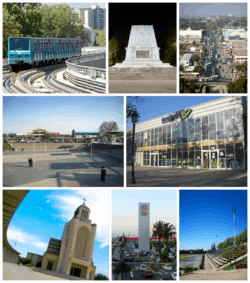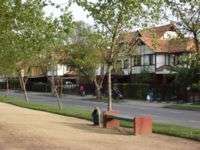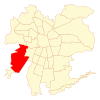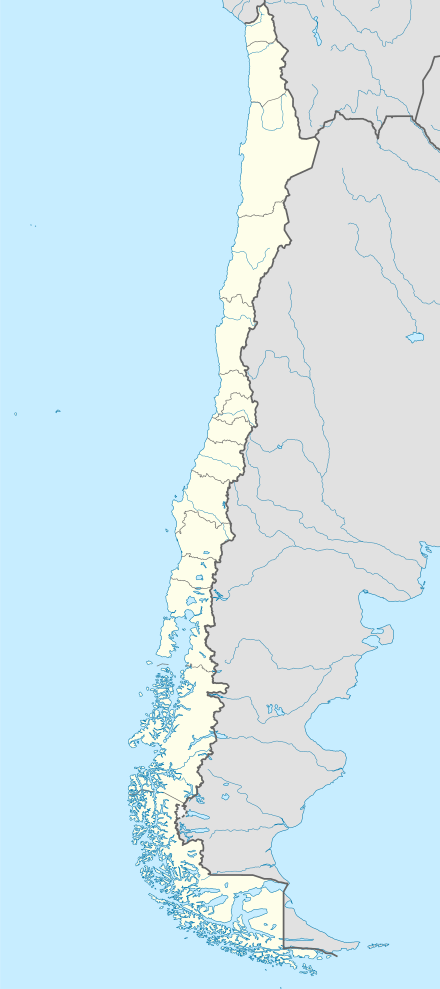Maipú, Chile
| Maipú | ||||||
|---|---|---|---|---|---|---|
| City and Commune | ||||||
 Top left:A Santiago Metro train arriving in Maipú, Top middle: Battle of Bailén Memorial, Top right: April 5th Avenue, Middle left: Maipú Main Square, Middle right: Maipu Municipal Theater, Bottom left: Votive Temple, Bottom middle: Mall Arauco Maipú, Bottom right: Santiago Bueras Stadium | ||||||
| ||||||
| Coordinates (city): 33°31′S 70°46′W / 33.517°S 70.767°WCoordinates: 33°31′S 70°46′W / 33.517°S 70.767°W | ||||||
| Country | Chile | |||||
| Region | Santiago Metro. | |||||
| Province | Santiago | |||||
| Government[1] [2] | ||||||
| • Type | Municipality | |||||
| • Alcalde | Cathy Barriga (UDI) | |||||
| Area[3] | ||||||
| • Total | 133 km2 (51 sq mi) | |||||
| Population (2002 Census)[3] | ||||||
| • Total | 468,390 | |||||
| • Density | 3,500/km2 (9,100/sq mi) | |||||
| • Urban | 464,882 | |||||
| • Rural | 3,508 | |||||
| Sex[3] | ||||||
| • Men | 227,285 | |||||
| • Women | 241,105 | |||||
| Time zone | UTC-4 (CLT [4]) | |||||
| • Summer (DST) | UTC-3 (CLST [5]) | |||||
| Area code(s) | 56 + | |||||
| Website | Municipality of Maipú | |||||
Maipú is a commune of Chile located in Santiago Province, Santiago Metropolitan Region, integrated into the Greater Santiago conurbation. It was founded on February 16, 1821 and it is the place of the Battle of Maipú (April 5, 1818), where Chile's independence was consolidated. Inhabitants are mostly part of a middle to upper-middle class young professionals.
According to the 2002 census, Maipú was the second largest commune in Chile, behind Puente Alto. However, the National Statistics Institute estimates that as of 2006, Maipú has surpassed the latter in population.
Demographics
According to the 2002 census of the National Statistics Institute, Maipú spans an area of 133 km2 (51 sq mi) and has 468,390 inhabitants (227,285 men and 241,105 women). Of these, 464,882 (99.3%) lived in urban areas and 3,508 (0.7%) in rural areas. The population grew by 82.6% (211,840 persons) between the 1992 and 2002 censuses.[3]
- Stats
- Average annual household income: US$45,664 (PPP, 2006)[6]
- Population below poverty line: 9.1% (2006)[7]
- Regional quality of life index: 76.67, mid-high, 21 out of 52 (2005)
- Human Development Index: 0.782, 20 out of 341 (2003)[8]
Administration
As a commune, Maipú is a third-level administrative division of Chile administered by a municipal council, headed by an alcalde who is directly elected every four years. The 2012-2016 alcalde is Christian Vittori Muñoz (PDC).[1][2] The communal council has the following members:
- Herman Silva Sanhueza (PDC)
- Alejandro Almendares Müller (IND)
- Marcelo Torres Ferrari (RN)
- Carol Bortnick De Mayo (PPD)
- Antonio Neme Fajuri (UDI)
- Carlos Jara Garrido (PPD)
- Marcela Silva Nieto (PS)
- Ariel Ramos Stocker (PC)
- Abraham Donoso Morales (PDC)
- Mauricio Ovalle Urrea (PDC)
Within the electoral divisions of Chile, Maipú is represented in the Chamber of Deputies by Pepe Auth (PPD) and Mónica Zalaquett (UDI) as part of the 20th electoral district, which consists entirely of the Santiago commune. The commune is represented in the Senate by Guido Girardi Lavín (PPD) and Jovino Novoa Vásquez (UDI) as part of the 7th senatorial constituency (Santiago-West).
Gallery
 Votive Temple of Maipú
Votive Temple of Maipú- Town hall
 Monument to Maipú Embrace
Monument to Maipú Embrace- The cross of Primo de Rivera's Hill
 Monument to the Conquerors of the winners of Bailen
Monument to the Conquerors of the winners of Bailen A neighbourhood in Maipu
A neighbourhood in Maipu
References
- 1 2 "Asociación Chilena de Municipalidades" (in Spanish). Retrieved 27 January 2011.
- 1 2 "Municipality of Maipú" (in Spanish). Retrieved 27 January 2011.
- 1 2 3 4 "National Statistics Institute" (in Spanish). Retrieved 13 December 2010.
- ↑ "Chile Time". WorldTimeZones.org. Archived from the original on 11 September 2007. Retrieved 26 September 2010.
- ↑ "Chile Summer Time". WorldTimeZones.org. Archived from the original on 11 September 2007. Retrieved 26 September 2010.
- ↑ "Chilean National Congress" (in Spanish).
- ↑ "Poverty in the Santiago Metropolitan Region" (PDF). Ministry of Planning of Chile (in Spanish). Archived from the original (PDF) on August 24, 2007.
- ↑ "The Trajectories of Human Development in the Communes of Chile (1994-2003)" (PDF). Government of Chile, Mideplán (in Spanish). UNDP. Archived from the original (PDF) on 7 July 2011. Retrieved 13 September 2010.
External links
- (in Spanish) Municipality of Maipú
- (in Spanish) Maipú a su servicio journal
- (in Spanish) MaipuCiudadano.cl, Diario Virtual de Maipú journal

.svg.png)


